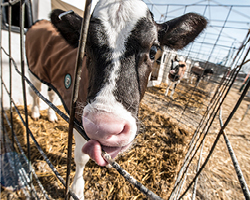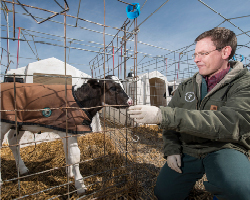Discovering the Growing Costs of a Growing Epidemic in the U.S. Dairy Industry

MSU Large Animal Clinical Sciences Professor Bo Norby designed a testing process to determine whether there is a connection between the prevalence of certain diseases and the different stages of bovine leukemia virus in infected cows.
- Bo Norby, D.V.M., Ph.D.
- Associate Professor, Department of Large Animal Clinical Sciences
- College of Veterinary Medicine
Dairy cow producers deal with the costly impacts of herd-health issues and cow well-being on a daily basis. While some health issues, such as mastitis and lameness, are well-known cost culprits, others have not been so obvious.
Bovine Leukemia Virus (BLV) has been a growing epidemic in U.S. dairy herds for decades, but because most BLV-positive cows are asymptomatic, it has received little attention from dairy producers. As a result, almost all American herds now have BLV-infected cows, a situation that may have far-reaching cost and animal welfare implications.
Bo Norby, building on the work of researchers from MSU's College of Veterinary Medicine, received a USDA grant last year to study the impact of BLV on the occurrence and severity of other diseases, such as mastitis, in dairy cows.
"We know that BLV has a negative impact on the immune system in cows that are infected," said Norby. "However, the major impacts on the immune system and susceptibility to other diseases might depend on the stage of the disease the cow is in."
MSU researchers have been studying BLV as far back as the 1980s, initially with Dr. John Kaneene, and more recently with a team led by Dr. Paul Bartlett (see box), who has been investigating BLV prevalence and impacts since 2010.
The Statistics
"BLV prevalence continues to increase to between 40 percent and 50 percent of all cows—beef and dairy—and the economic impact for dairy cows is much greater than previously thought," said Bartlett. "Most of the cost is lower milk production and shortened cow life span."
BLV is a tumor-causing retrovirus that infects lymphocytes (a type of white blood cell) in cattle. It causes an incurable contagious disease, enzootic bovine leukosis, which is asymptomatic in 60-70 percent of cows. However, after a period of latency, up to 30 percent of cows may develop an increase in lymphocytes, and a very small percentage of infected cows may actually develop lymphomas or tumors. The latter will result in cows being deemed unsuitable for human consumption when slaughtered.
The USDA periodically monitors for diseases, including BLV. In their 2007 survey, which tested for BLV antibodies in the bulk tank milk of 534 dairy operations, it was found that over 83% of dairies in the U.S. have infected cows.[1]
MSU Bovine Leukemia Virus Research Team
Paul C. Bartlett, M.P.H., D.V.M, Ph.D.
Professor, Large Animal Clinical Sciences
Oscar J. Benitez-Rojas, D.V.M.
Graduate Student, Comparative Medicine and Integrative Biology
Todd M. Byrem, Ph.D.
Adjunct Assistant Professor
Director of Research, NorthStar Cooperative
Paul Coussens, Ph.D.
Professor, Animal Science
Casey Droscha, Ph.D.
Associate Director of Research, NorthStar Cooperative
Phil Durst, M.S., P.A.S.
Senior Extension Educator, MSU Extension
Ron Erskine, D.V.M., Ph.D.
Professor, Large Animal Clinical Sciences
Meredith Frie
Graduate Student, Animal Science
Daniel L. Grooms, D.V.M., Ph.D.
Professor and Chair, Large Animal Clinical Sciences
Holden Hutchinson, B.S.
Graduate Student, Comparative Medicine and Integrative Biology
Chris Kellogg, M.S., D.V.M.
Graduate Student, Comparative Medicine and Integrative Biology
Rebecca LaDronka, M.P.H., D.V.M.
Graduate Student, Comparative Medicine and Integrative Biology
Bo Norby, D.V.M., M.P.V.M., Ph.D.
Associate Professor, Large Animal Clinical Sciences
Jennifer Roberts, D.V.M.
Professor, Large Animal Clinical Sciences
Vickie Ruggiero
Graduate Student, Comparative Medicine and Integrative Biology
Lorraine Sordillo, M.S., Ph.D.
Professor, Large Animal Clinical Sciences
In Denmark, Norby's native country, BLV is not an issue. Many countries in Europe and around the world decided in the mid to late 20th century to address BLV and as a result, over 21 countries have now been able to eradicate the disease. Therefore, it wasn't until after Norby arrived in the U.S. that he became interested in the issue. When he joined MSU's faculty in 2011, he began to work on some of the research grants of Bartlett and others.
A Collaborative Effort
For his current project, Norby and the team designed a testing process to determine whether there is a connection between the development of certain diseases, especially mastitis and lameness, and the different stages of BLV in infected cows. Local dairy producers have enrolled their cows in the study.
"We enroll the cows a few months before they're due to have their next calf, and then we are basically following them through one lactation cycle," explained Norby. The process lasts about 13 months, during which time Norby's team will test them several times to record any change in their BLV and health status for cows in different stages of the disease. After, they will compare BLV-positive cows in different stages of the disease with BLV-negative cows. Their hypothesis is that BLV-positive cows, especially those with increased lymphocyte count, are more likely to develop secondary diseases in that period of time.
The MSU team is working with two diagnostic partners to do the testing: Advanced Animal Diagnostics, headquartered in North Carolina, and NorthStar Cooperative, a beef and dairy product and service provider in Lansing, Michigan. Dr. Casey Droscha, associate director of research at NorthStar, is developing a new test to get the data for the MSU study. His colleague, Dr. Todd Byrem, director of research at NorthStar, explains the testing that will be done.
"To study the pathophysiology of BLV and the mechanisms of cow-to-cow transmission, it will be important to accurately quantify changes in both blood lymphocyte counts and proviral DNA counts during the progression of disease after infection," explained Byrem." Data collected from serial blood testing in infected animals will determine the predictive value of proviral load in assessing immune dysfunction and infectivity. With sufficient predictive value, the new molecular-based proviral load assay could be used to cost-effectively eliminate this disease in high BLV prevalence cattle populations such as in the U.S."
Bringing Down the Numbers
Ultimately, the goal is to make producers appreciate that they should implement management practices to reduce transmission of the disease, which is primarily spread through blood and other body fluids. It is especially important to identify and segregate cows known as "super-shedders," those who are most likely to spread the disease to other cows.
"We are seeing that identifying and removing the super-shedders can greatly reduce transmission," said Bartlett. "These super-shedders have two to three thousand times more infectious particles per unit of blood [than other infected cattle]."
But implementing testing and management practices is expensive and will require producer buy-in.
"If cows aren't sick, producers don't recognize it," explained Norby. "But if we could tie the infection to some of the diseases they see on a daily basis, it might be more likely to get them to recognize the negative effects of the disease, and maybe bring down the proportion of cows that are infected."

"We know that bovine leukemia virus has a negative impact on the immune system in cows that are infected. However, the major impacts on the immune system and susceptibility to other diseases might depend on the stage of the disease the cow is in," says Bo Norby, MSU Large Animal Clinical Sciences associate professor.
Howard Straub is the dairy manager of the Kellogg Biological Station's Pasture Dairy Center, and is responsible for scheduling and organizing the testing of cows. "I take the results provided to me by Drs. Norby and Bartlett and the BLV team, and interpret and implement the results on our dairy herd," he said. This includes deciding how and when to cull the herd in a way that doesn't financially hurt the Center.
According to Straub, when BLV testing started at the KBS facility, there was a 62 percent prevalence of BLV in their herd. Simply culling (or selling off) all the infected cows would have been financially devastating for the farm. The solution has been to use testing to find the worst offenders (super-shedders) and gradually cull these animals.
The result is that, in three years, herd prevalence has dropped to 33 percent, and Straub hopes that slowing the spread of disease will result in less future culling of animals.
"I believe the testing Dr. Norby and others are developing can and will be used to reduce BLV in the U.S. commercial herd," said Straub, "and that the management strategies implemented at the Pasture Dairy Center are completely transferable to commercial dairies around the U.S."
If Norby's hypothesis holds—that cows in certain stages of BLV are more likely to develop other diseases—then the next step might be to enroll sociologists, who can help relay this information to producers to generate interest in doing something about BLV in their herds.
For Norby, it's all about improving the sustainability of the dairy industry in Michigan and the U.S. "I want to be able to come up with some strategies to help producers get rid of this disease," he said. "Because it costs money to treat sick cows and it affects the welfare of the cows, getting rid of the disease is going to have a lot of positive impacts, both for the dairy cows themselves, and also for the producers that have them."
For more information about BLV research being conducted at MSU, please visit the MSU Bovine Leukemia Virus website.
Sources
- U.S. Department of Agriculture, Animal and Plant Health Inspection Service. (2008, October). Bovine Leukosis Virus (BLV) on U.S. dairy operations, 2007 (APHIS Info Sheet). Retrieved from http://www.aphis.usda.gov/animal_health/nahms/dairy/downloads/dairy07/Dairy07_is_BLV.pdfBack to article
- Written by Amy Byle, University Outreach and Engagement
- Photograph courtesy of MSU Communications and Brand Strategy